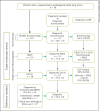Endoscopic Ultrasound with Bronchoscope-Guided Fine Needle Aspiration for the Diagnosis of Paraesophageally Located Lung Lesions
- PMID: 30253411
- PMCID: PMC6518855
- DOI: 10.1159/000492578
Endoscopic Ultrasound with Bronchoscope-Guided Fine Needle Aspiration for the Diagnosis of Paraesophageally Located Lung Lesions
Abstract
Background: Diagnosing centrally located lung tumors without endobronchial abnormalities and not located near the major airways is a diagnostic challenge. Tumors near or adjacent to the esophagus can be aspirated and detected with esophageal ultrasound (EUS) using gastrointestinal endoscopes.
Objective: To assess the feasibility and diagnostic yield of endoscopic ultrasound with bronchoscope-guided fine needle aspiration (EUS-B-FNA) in paraesophageally located lung tumors and its added value to bronchoscopy and endobronchial ultrasound (EBUS).
Methods: Retrospective, multicenter international study (from January 1, 2015 until January 1, 2018) of patients with suspected lung cancer, undergoing bronchoscopy, EBUS, and endoscopic ultrasound bronchoscopy (EUS-B) in one session by a single operator (pulmonologist), in whom the primary lung tumor was detected and aspirated by EUS-B. In the absence of malignancy following endoscopy, transthoracic ultrasound needle aspiration, clinical and radiological follow-up of at least 6 months was performed. The yield and sensitivity of EUS-B-FNA and its added value to bronchoscopy and EBUS was assessed.
Results: 58 patients were identified with the following diagnosis: non-small-cell lung cancer (n = 43), small-cell lung cancer (n = 6), mesothelioma (n = 2), metastasis (n = 1), nonmalignant (n = 6). The yield and sensitivity of EUS-B-FNA for detecting lung cancer was 90%. In 26 patients (45%), the intrapulmonary tumor was exclusively detected by EUS-B. Adding EUS-B to conventional bronchoscopy and EBUS increased the diagnostic yield for diagnosing lung cancer in para-esophageally located lung tumors from 51 to 91%. No EUS-B-related complications were observed.
Conclusion: EUS-B-FNA is a feasible and safe technique for diagnosing centrally located intrapulmonary tumors that are located near or adjacent to the esophagus. EUS-B should be considered in the same endoscopy session following nondiagnostic bronchoscopy and EBUS.
Keywords: Diagnosis; Endobronchial ultrasound; Esophageal ultrasound; Lung cancer.
© 2018 The Author(s) Published by S. Karger AG, Basel.
Figures


Similar articles
-
Combined endobronchial and esophageal endosonography for the diagnosis and staging of lung cancer: European Society of Gastrointestinal Endoscopy (ESGE) Guideline, in cooperation with the European Respiratory Society (ERS) and the European Society of Thoracic Surgeons (ESTS).Endoscopy. 2015 Jun;47(6):545-59. doi: 10.1055/s-0034-1392040. Epub 2015 Jun 1. Endoscopy. 2015. PMID: 26030890
-
Pulmonologist-performed transoesophageal sampling for lung cancer staging using an endobronchial ultrasound video-bronchoscope: an Australian experience.Intern Med J. 2017 Feb;47(2):205-210. doi: 10.1111/imj.13330. Intern Med J. 2017. PMID: 27860078
-
[A Case of Left Upper Lobe Lung Cancer Successfully Diagnosed by Transesophageal Endoscopic Ultrasound with Bronchoscope-Guided Fine Needle Aspiration Alone].J UOEH. 2019;41(2):243-248. doi: 10.7888/juoeh.41.243. J UOEH. 2019. PMID: 31292371 Japanese.
-
Utility and Safety of Endoscopic Ultrasound With Bronchoscope-Guided Fine-Needle Aspiration in Mediastinal Lymph Node Sampling: Systematic Review and Meta-Analysis.Respir Care. 2015 Jul;60(7):1040-50. doi: 10.4187/respcare.03779. Epub 2015 Mar 10. Respir Care. 2015. PMID: 25759463 Review.
-
Transesophageal endoscopic ultrasound with bronchoscope-guided fine-needle aspiration for diagnostic and staging purposes: a narrative review.J Thorac Dis. 2023 Sep 28;15(9):5088-5098. doi: 10.21037/jtd-23-681. Epub 2023 Aug 21. J Thorac Dis. 2023. PMID: 37868849 Free PMC article. Review.
Cited by
-
Diagnosis and staging of lung cancer with the use of one single echoendoscope in both the trachea and the esophagus: A practical guide.Endosc Ultrasound. 2021 Sep-Oct;10(5):325-334. doi: 10.4103/EUS-D-20-00139. Endosc Ultrasound. 2021. PMID: 33666182 Free PMC article.
-
Intracardiac EUS-B-Guided FNA for Diagnosing Cardiac Tumors.Respiration. 2021;100(9):918-922. doi: 10.1159/000516504. Epub 2021 Jun 24. Respiration. 2021. PMID: 34167124 Free PMC article.
-
Endoscopic ultrasound-guided fine-needle aspiration using the bronchial ultrasound scope (EUS-B-FNA) for diagnosing pancreatic metastasis in a lung cancer patient case report.Eur Clin Respir J. 2023 Dec 25;11(1):2294545. doi: 10.1080/20018525.2023.2294545. eCollection 2024. Eur Clin Respir J. 2023. PMID: 38178814 Free PMC article.
-
Safety and feasibility of oesophageal ultrasound for the work-up of thoracic malignancy in patients with respiratory impairment.J Thorac Dis. 2023 Jul 31;15(7):3965-3973. doi: 10.21037/jtd-22-1705. Epub 2023 Jun 27. J Thorac Dis. 2023. PMID: 37559642 Free PMC article.
-
Transesophageal endoscopic ultrasound-guided tissue acquisition of lung masses: a case series with systematic review and meta-analysis.Ann Gastroenterol. 2023 Mar-Apr;36(2):185-194. doi: 10.20524/aog.2023.0778. Epub 2023 Feb 2. Ann Gastroenterol. 2023. PMID: 36864937 Free PMC article.
References
-
- Global Burden. of Disease Cancer Collaboration Global, regional, and national cancer incidence, mortality, years of life lost, years lived with disability, and disability-adjusted life-years for 32 cancer groups, 1990 to 2015: a systematic analysis for the global burden of disease study. JAMA Oncol. 2017;3:524–548. - PMC - PubMed
-
- Rivera MP, Mehta AC, Wahidi MM. Establishing the diagnosis of lung cancer: Diagnosis and management of lung cancer, 3rd ed: American College of Chest Physicians evidence-based clinical practice guidelines. Chest. 2013;143((5 Suppl)):e142S–e165S. - PubMed
-
- Du Rand IA, Barber PV, Goldring J, Lewis RA, Mandal S, Munavvar M, et al. British Thoracic Society guideline for advanced diagnostic and therapeutic flexible bronchoscopy in adults. Thorax. 2011;66:iii1–iii21. - PubMed
-
- Popovich J, Kvale PA, Eichenhorn MS, Radke , Jr, Ohorodnik JM, Fine G. Diagnostic accuracy of multiple biopsies from flexible fiberoptic bronchoscopy. Am Rev Respir Dis. 1982;125:521–523. - PubMed
-
- Mazzone P, Jain P, Arroliga AC, Matthay RA. Bronchoscopy and needle biopsy techniques for diagnosis and staging of lung cancer. Clin Chest Med. 2002;23:137–158. ix. - PubMed
Publication types
MeSH terms
LinkOut - more resources
Full Text Sources
Other Literature Sources
Medical

